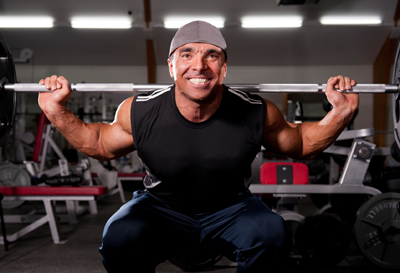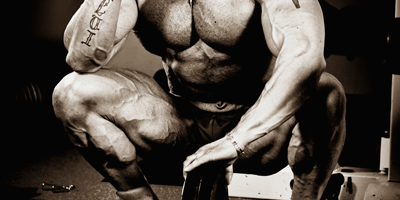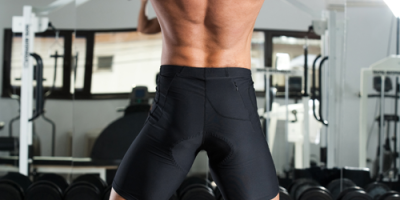Some use an aerobic box or platform, and the Westside Barbell crew say that Elite FTS sells one online. You can also use rubber bumper plates the gym – though that may be selfish if the supply in your gym isn’t great.
EXECUTION OF BOX SQUAT:
Box Squat Starting Position –
The starting position on Box Squats is similar as for Squats. But you’ll use a slightly wider stance.
Make sure the bar is stationed low on your back to begin. A high bar doesn’t work for Box Squats. Put the bar low, on top of your scapular spine.
Use a narrow Grip –
Narrow makes it easier to keep your upper-back tight, which adds strength.
Foot Stance –
Shouldn’t be a sumo stance, but should be wider than your shoulder-width. Feet should be turned out about 30 degrees.
Tight upper-back –
Imagine squeezing a pen between your shoulder blades. Keep this position during the whole lift.
Keep chest up –
Stick chest outward and keep it up. This together with the tight upper-back will prevent your back from bending.
Look Forward –
Fix a point in front of you during the whole lift. Don’t look up or down, just look forward or through the mirror.
Push Your Abs Out –
This increases lower back stability. Push abs out as if someone was going to punch you in your stomach.
HOW TO SQUAT DOWN ON BOX:
Lower yourself by moving your hips first. Your knees should hardly move during Box Squats, it all comes from your hips.
Sit Back, and lead by pushing your hips back as far as you can. Think sitting on a toilet. Your knees don’t move, your hips move back – which is why keeping your chest and abs out stabilize.
Shins are perpendicular to the floor – even past perpendicular to the floor. You’ll get this by moving your hips first. Push them back as far as you can.
Keep the knees out – your upper-thighs must stay in line with your feet to avoid knee injuries. Imagine pushing your knees out in the same direction as where your toes point.
Sit down on the box, but do not let yourself fall down on it.
Lower yourself under good control – not slowly, but also not a quick touch and go. It should be fluid and controlled.
Remember to stay tight – don’t relax your muscles, it can cause back injuries. Keep all your muscles tight on the box.
HOW TO SQUAT OFF THE BOX:
Stay tight, keep your chest up and look forward. Squat up by thinking “hips up,” do not lean forward.
Plant heels firmly on the floor, and curl your toes. Heels keep you from losing balance. Push from the outer side of your feet, and explode. You can’t do Box Squats slowly. Think: Explode upward from hips. That’s how Box Squats build hip power.
COMMON BOX SQUAT MISTAKES OF EXECUTION:
As with any weight lifting exercise, the lower back can become compromised if you don’t execute correct form. The key is to sit on the box and stay tight, not to bounce or relax at any point.
Mistake 1: Bouncing off The Box – This sandwiches your spine between the bar and the box, causing back injuries. Lower yourself under control to sit on the box for a brief moment and begin coming up.
Mistake 2: Relaxing on The Box – When you do this, your spine gets the whole load as surrounding muscles can’t provide support. Stay tight, push your abs out.
Mistake 3: Keeping Knees Forward – It kills posterior chain strength. Keep your shins at perpendicular to the floor – or past. Lower yourself by pushing your hips back.
Mistake 4: Rocking Forward – Won’t allow you to use your glutes effectively and will risk back injury. Squat up by moving your hips up. Keep your torso still.
Mistake 5: Leaning Forward – Can make your back round. Instead, look forward, keeping a big chest, with shoulder blades back and down; arch your back, push your abs out. Squat.
Mistake 6: Keeping knees in – This puts uneven compression on knee joint. Push your knees out from start to finish. Keep your thighs in line with your feet.
By squatting deeper than you imagined in a cage, box squats allow you to isolate all the correct muscles. Through isolating all the correct muscles, it enables you to develop additional flexibility, and muscle development, and quickly improves your pulling strength for things like deadlifts and Olympic pulls. In a word, box squats are the versatility lifters need to move past those plateaus, and a great start for beginners to ingrain the most correct form.



